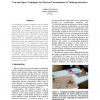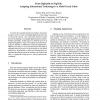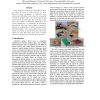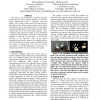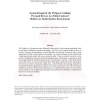85
Voted
TABLETOP
2008
IEEE
15 years 6 months ago
2008
IEEE
117
click to vote
TABLETOP
2008
IEEE
15 years 6 months ago
2008
IEEE
To realize the potential of multi-touch tables, interaction designers need to create meaningful applications for them in real-world contexts. One convenient shortcut towards that ...
98
Voted
TABLETOP
2008
IEEE
15 years 6 months ago
2008
IEEE
We propose a variant of the multi-touch display technology that introduces an original way of manipulating threedimensional data. The underlying metaphor is that of a deformable s...
87
Voted
TABLETOP
2008
IEEE
15 years 6 months ago
2008
IEEE
In this paper we describe extensions to our work on ThinSight, necessary to scale the system to larger tabletop displays. The technique integrates optical sensors into existing of...
TABLETOP
2008
IEEE
15 years 6 months ago
2008
IEEE
Many interactive surfaces have the ability to detect the shape of hands or objects placed on them. However, shape information is typically either condensed to individual contact p...
106
Voted
TABLETOP
2008
IEEE
15 years 6 months ago
2008
IEEE
In this paper we present a novel approach to text input on large interactive surfaces using a combination of strategies to resolve the inherent difficulties with text input on su...
99
Voted
TABLETOP
2008
IEEE
15 years 6 months ago
2008
IEEE
Knowledge workers often undertake tasks that involve a variety of information artifacts, including both paper and digital documents. In this paper, we first summarize findings fro...
119
click to vote
TABLETOP
2008
IEEE
15 years 6 months ago
2008
IEEE
We present a new approach for rapidly prototyping multi-touch and object sensing surfaces. It works by liquid displacement inside a malleable projection surface. The system provid...
TABLETOP
2008
IEEE
15 years 6 months ago
2008
IEEE
The WeSpace is a long-term project dedicated to the creation of environments supporting walkup and share collaboration among small groups. The focus of our system design has been ...
92
Voted
TABLETOP
2008
IEEE
15 years 6 months ago
2008
IEEE
In the real world, a physical tabletop provides public and private needs for people around the table. For competing scenarios such as playing a poker game or running a price negot...
